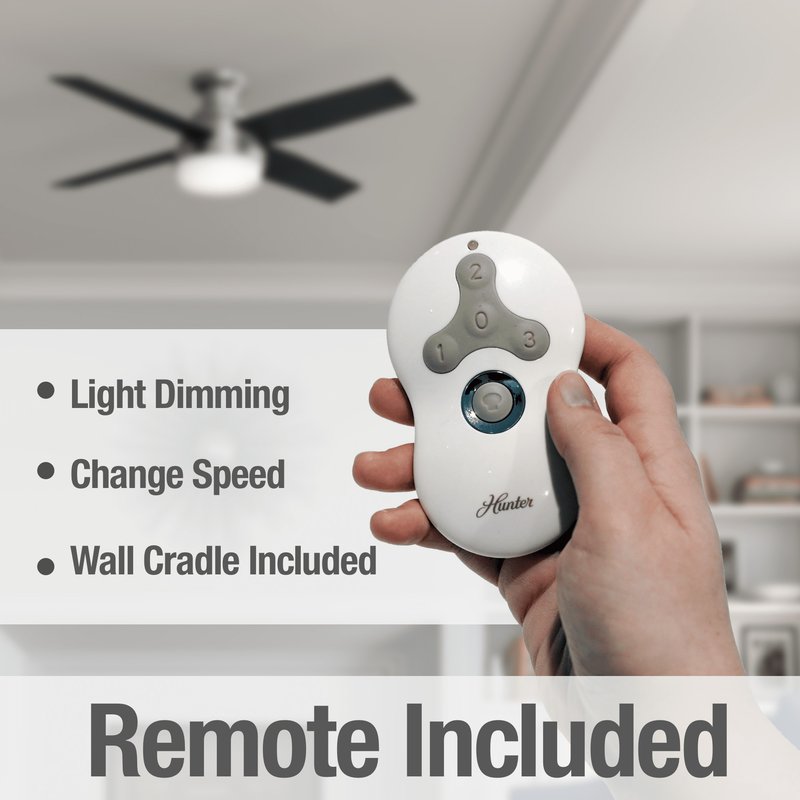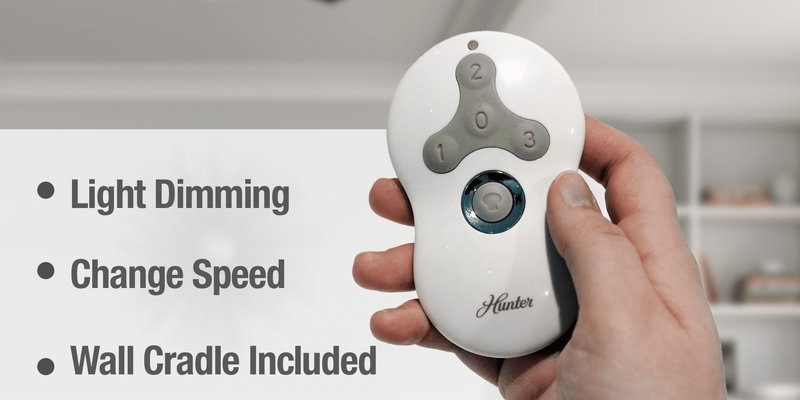
If you’ve ever craned your neck at a fan way out of arm’s reach and wondered if that small Hunter remote can still cut it, you’re not the only one. Hunter is a popular brand for ceiling fans, and their remotes are designed to make life easier, not turn you into a gymnast. Still, using a remote on a high ceiling brings in questions about range, reliability, and those annoying “why won’t it work?” moments. Let’s break down how these remotes are built to function, what you’ll need to know for a high ceiling setup, and the little quirks that can pop up when your fan is riding high.
How Hunter Ceiling Fan Remotes Work: The Basics
Here’s the thing: A Hunter ceiling fan remote isn’t that different from your TV remote, except it’s designed to control fan speed, direction, and light settings. These remotes use either infrared (IR) or, more commonly, radio frequency (RF) signals to communicate with a receiver installed in the fan motor.
Radio frequency is the preferred technology for most Hunter remotes these days, because you don’t need to point them RIGHT at the fan. The signal can travel through walls, furniture, and—yes—even the vertical distance of a high ceiling.
Installation-wise, most Hunter fans that come with remotes include a pre-installed receiver. If you’re adding a remote kit to an older fan, you’d mount the receiver in the canopy or housing at the ceiling. Once the receiver is wired and you’ve popped batteries into the remote, you use a “pairing” or “sync” process (sometimes called “learning the code”) to connect the two.
Tip: If you’ve just moved into a home with a Hunter fan but no remote, check for a receiver in the fan before buying a new kit. The whole setup depends on both ends—remote and receiver—knowing how to talk to each other.
Remote Range and Signal Strength: Can It Handle Tall Ceilings?
Now, about those towering ceilings. The main concern with using a Hunter ceiling fan remote on high ceilings is whether the remote’s signal can reliably reach the receiver, which could be 12, 15, or even 20 feet above your head.
Most Hunter RF remotes are rated for a range of at least 30–50 feet. That covers nearly every residential high ceiling out there. The signal projects in all directions, not just straight up, so you don’t need to stand directly under the fan.
But real-world clutter can throw a wrench in the works. Metal beams, thick concrete, or even a dense cluster of electronics can weaken RF signals. For example, if you’re trying to control a fan in a vaulted living room with a loft or metal balcony, you might find a “dead zone” where the remote is less reliable.
If you notice the remote working from the kitchen but not from your favorite chair, it’s probably not the ceiling height—it’s the signal path or interference at play. Reposition yourself, or try changing the angle you’re pointing the remote.
Pairing, Syncing, and Resetting Hunter Remotes on High Ceilings
Pairing a Hunter remote with a high-ceiling fan is pretty much the same as with a standard ceiling fan, but you might run into some unique challenges if you ever need to reset or re-sync your devices.
First, let’s run through the typical pairing process:
- Power off the fan using the wall switch or breaker, then restore power (this puts the receiver in “learning” mode for a few seconds).
- Within 30 seconds, press and hold the pairing button on your remote (usually marked as “Sync” or sometimes hidden under the battery cover).
- If pairing is successful, the fan will usually beep or the lights will blink.
On a high ceiling, this setup is trickier if the receiver’s “learn” button or reset button isn’t remote-accessible. You might need a ladder for the initial pairing (annoying, but usually a one-time thing). If your fan loses sync, or you need to change the code to avoid interference with a neighbor’s remote, you’ll have to repeat this process.
Honestly, if you have to pair or reset the system frequently, something else might be wrong—old batteries, interference, or a worn-out receiver are common culprits.
Batteries, Maintenance, and Troubleshooting Signal Issues
You might be wondering, “If my Hunter ceiling fan remote isn’t working, is it just the batteries?” Nine times out of ten, it’s that simple. High ceilings don’t drain batteries faster, but it can really feel like “the fan is broken” when all you need is a battery swap.
Signs of battery problems: The remote works when you’re close to the fan but loses power at a distance, or the buttons become unresponsive altogether. Pop open the battery cover, make sure the contacts are clean, and replace with fresh AAAs or 9-volts (depending on your model).
If new batteries don’t solve the problem, check for other interference. Wi-Fi routers, microwaves, and even cordless phones can mess with RF signals. Moving these devices a few feet away from your usual “remote zone” can sometimes restore full function.
Finally, if nothing works—yes, you might need to get on a ladder and check the receiver. Loose wiring or a burnt-out receiver are rare but possible, especially if your home’s seen a lot of renovation or power surges.
Hunter Remote Codes and Avoiding Interference on High Ceilings
Every Hunter remote works using a unique “code” that matches it to its receiver. This prevents your remote from accidentally controlling your neighbor’s fan or vice versa. On a high ceiling, especially in apartment complexes or condos with lots of fans stacked above and below, code conflicts can occasionally pop up.
Here’s how to avoid it:
- Check your remote and receiver for DIP switches (tiny toggles usually near the battery compartment or receiver housing).
- Set both devices to the same code—just match the switch positions exactly.
- If you’re still picking up a neighbor’s fan, change the code on both devices.
Some newer Hunter models use “auto-pairing” instead of physical switches, but the concept is the same. The only hassle is you’ll need ladder access if the receiver is tucked up high.
Honestly, once you’ve got your code set and paired, you can use the remote from just about anywhere in the room—height isn’t a problem unless you live in an actual bell tower.
Comparing Hunter Remote Options for High Ceilings
Not all Hunter ceiling fan remotes are created equal—especially when you throw high ceilings into the mix. There are a few variations worth comparing:
- Wall-mount remotes: These act like a regular wall switch but use RF to talk to the fan. Perfect if you want a “home base” location and don’t want to fumble for a handheld remote on the couch.
- Handheld remotes: Great for mobility, but easier to lose in couch cushions. Fully functional for high ceilings if you stay within range.
- Universal remotes: Designed to work across different brands or models—helpful if you have multiple fans, but you might lose out on a few Hunter-specific features like special dimming controls or reverse mode.
If you’re mostly worried about reaching a fan 20 feet overhead, either type will work as long as the RF signal isn’t blocked. Wall-mount options are a favorite if you want to avoid “where’s the remote?!” moments, especially in busy living rooms.
Let me explain: High ceiling or not, the main question is convenience. Wall-mounts give you a set location; handhelds give you flexibility. Both handle ceiling height with ease if the signal isn’t obstructed.
When a Hunter Ceiling Fan Remote Won’t Work: Common Pitfalls and Solutions
Even with top-rated technology, sometimes things just don’t click. Maybe your Hunter ceiling fan remote works perfectly for months, then suddenly flakes out—especially in a room with a soaring ceiling. Here are the most common pitfalls:
- Receiver placement: If the receiver is crammed tightly with wires or surrounded by metal, signal loss becomes a real headache. Try to keep it as unobstructed as possible during installation.
- Dead or weak batteries: Obvious, but don’t overlook it. A high-ceiling install makes you less likely to give the fan a “manual” test, so weak batteries hide longer.
- Electrical interference: Those big surround-sound speakers or fancy lighting systems? Sometimes they interfere with the remote signal. Test from different positions or move electronics slightly to troubleshoot.
- Outdated firmware or hardware: If you’re using a Hunter remote and receiver kit from the early 2000s, you might run into compatibility issues with new installations. Sometimes a universal kit or direct replacement is the fix.
If you’ve ruled out all the basics and still have issues, reaching out to Hunter support can help. They’re used to troubleshooting weird “high ceiling” quirks and can often talk you through the process without an expensive service call.
Hunter Ceiling Fan Remotes vs. Smart Controls for High Ceilings
You might be tempted to skip the classic remote and ask, “Should I just upgrade to a smart ceiling fan controller instead?” For high ceilings, smart technology does offer some advantages, like using your phone or voice to control the fan. No more losing the remote. Some Hunter fans now include Wi-Fi integration or work with platforms like Alexa or Google Home.
But there’s a caveat: Smart controls often need a strong Wi-Fi signal or a compatible hub. If your living room Wi-Fi is already a bit spotty, a traditional RF remote is the more reliable option—especially since you don’t have to mess with apps or software updates.
Still, for multi-story homes or open floorplans, mixing a Hunter remote with a smart system gives you the best of both worlds. Remote for quick changes, app for advanced scheduling or automation.
Final Thoughts: Using Your Hunter Ceiling Fan Remote With High Ceilings
Here’s the bottom line: You can absolutely use a Hunter ceiling fan remote on high ceilings, and honestly, it’s one of the best reasons to have a remote in the first place. The RF technology is up to the challenge, as long as the receiver and remote are paired correctly, the batteries are fresh, and you avoid signal-blocking clutter.
If you’re sorting out a new install, double-check the code and receiver placement. If you ever run into trouble, just remember—most issues are simple fixes. High ceilings shouldn’t mean climbing a ladder every time you want a breeze. With the right Hunter remote (and a bit of patience during setup), enjoying perfect airflow from way down below is totally within reach.
